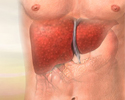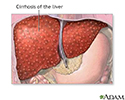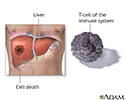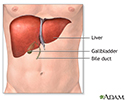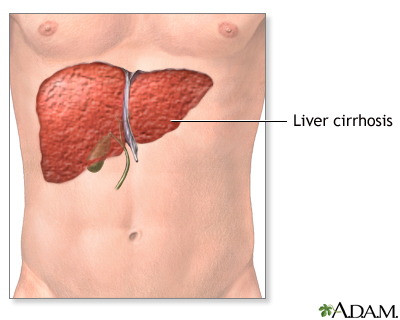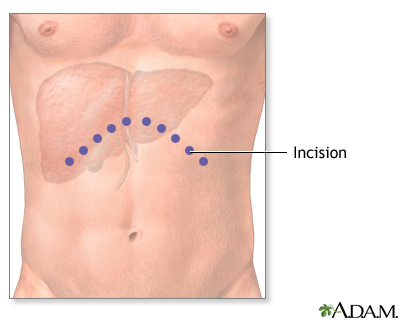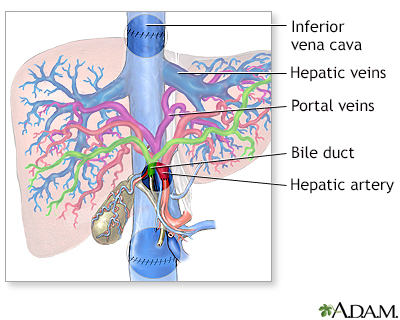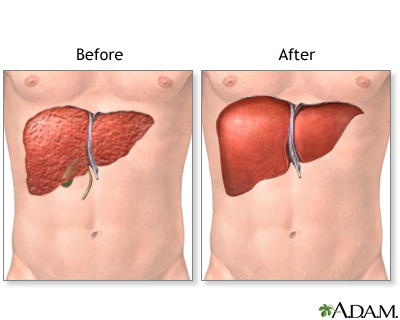Liver disease
The term "liver disease" applies to many conditions that stop the liver from working or prevent it from functioning well. Abdominal pain or swelling, yellowing of the skin or eyes (jaundice), or abnormal results of liver function tests may suggest you have liver disease. Related topics include:Alpha-1 anti-trypsin deficiencyAmebic liver...
Alcoholic liver disease - Animation
Alcoholic liver disease
Animation
Hodgkin's disease - liver involvement
Hodgkin's disease (lymphoma) is a malignant cancer that can affect many organs. A whitish, irregular tumor mass of lymphoma cells is seen on the left side of this cross-section of the liver.
Hodgkin's disease - liver involvement
illustration
Cirrhosis of the liver
A chronic liver disease which causes damage to liver tissue, scarring of the liver (fibrosis; nodular regeneration), progressive decrease in liver function, excessive fluid in the abdomen (ascites), bleeding disorders (coagulopathy), increased pressure in the blood vessels (portal hypertension), and brain function disorders (hepatic encephalopathy). Excessive alcohol use is the leading cause of cirrhosis.
Cirrhosis of the liver
illustration
Liver cell death
Organisms that carry disease can travel through the blood stream into the liver and form an abscess, a collection of infected tissue and pus.
Liver cell death
illustration
Liver transplant - series
Presentation
Hodgkin's disease - liver involvement
Hodgkin's disease (lymphoma) is a malignant cancer that can affect many organs. A whitish, irregular tumor mass of lymphoma cells is seen on the left side of this cross-section of the liver.
Hodgkin's disease - liver involvement
illustration
Cirrhosis of the liver
A chronic liver disease which causes damage to liver tissue, scarring of the liver (fibrosis; nodular regeneration), progressive decrease in liver function, excessive fluid in the abdomen (ascites), bleeding disorders (coagulopathy), increased pressure in the blood vessels (portal hypertension), and brain function disorders (hepatic encephalopathy). Excessive alcohol use is the leading cause of cirrhosis.
Cirrhosis of the liver
illustration
Liver cell death
Organisms that carry disease can travel through the blood stream into the liver and form an abscess, a collection of infected tissue and pus.
Liver cell death
illustration
Liver transplant - series
Presentation
Liver disease
The term "liver disease" applies to many conditions that stop the liver from working or prevent it from functioning well. Abdominal pain or swelling, yellowing of the skin or eyes (jaundice), or abnormal results of liver function tests may suggest you have liver disease. Related topics include:Alpha-1 anti-trypsin deficiencyAmebic liver...
Liver disease
The term "liver disease" applies to many conditions that stop the liver from working or prevent it from functioning well. Abdominal pain or swelling, yellowing of the skin or eyes (jaundice), or abnormal results of liver function tests may suggest you have liver disease. Related topics include:Alpha-1 anti-trypsin deficiencyAmebic liver...
Review Date: 5/14/2024
Reviewed By: Jenifer K. Lehrer, MD, Department of Gastroenterology, Aria - Jefferson Health Torresdale, Jefferson Digestive Diseases Network, Philadelphia, PA. Review provided by VeriMed Healthcare Network. Also reviewed by David C. Dugdale, MD, Medical Director, Brenda Conaway, Editorial Director, and the A.D.A.M. Editorial team.

